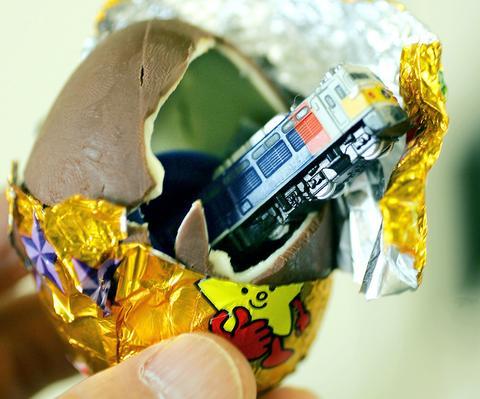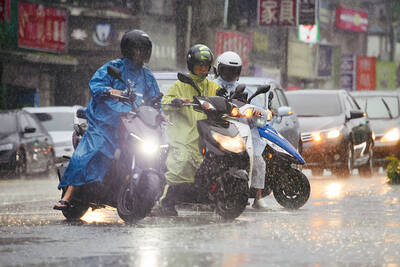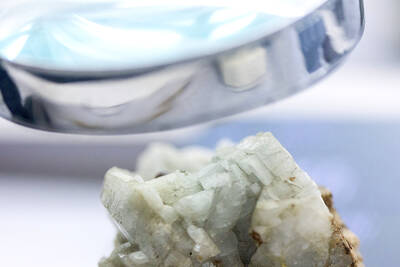The idea seemed a good one: Go one better than bubble-gum cards and buried cereal treasures and offer high-quality collectible action figures, toy-model kits and other toys to sell snacks.
Japan's confectioners had visions of profits ballooning when they hit on this marketing strategy, hoping to attract not only kids but their parents, too.
Naoko Takayama was among the enthusiastic collectors lured by the gimmick.

PHOTO: REUTERS
The 34-year-old part-time worker has spent around US$9,000 in the past three years to collect 2,200 parakeets -- a thumb-sized plastic prize packed in Choco-Egg, an egg-shaped hollow chocolate made by unlisted confectioner Furuta Seika.
"Now my room is full of parakeets, just like [Alfred] Hitchcock's movie The Birds," Takayama said.
But the initial boom that created an adult snack market has taken an unforeseen turn, forcing confectioners like Ezaki Glico Co, among the industry's leaders, to rethink their strategies.
"The market, unpredictably, became only for avid adult collectors and we are finding it difficult to attract general shoppers," said Glico spokesman Tsuyoshi Kiriishi.
"We need to make products that appeal to general consumers to step ahead of our rivals in the competitive snack market," Kiriishi said.
The idea for the toy-and-snack boxes, called shokugan in Japanese, came from Fererro Japan Ltd, the Japanese unit of Italy's Fererro Group, which put a chocolate variation of the boxes on Japan's store shelves in 1998.
Japanese companies followed suit, tying up with popular plastic model maker Kaiyodo, to include toys from air planes and animals to "British Museum Collection" pieces at prices ranging from ?150 (YS$1.37) to about ?500, against an average price range of about ?100 to ?200 for general sweets.
Shokugan became a hit, especially among males in the their 30s and 40s, with the market growing to ?60 billion in 2002, up 40 percent from 1998, according to data from Glico.
But while collectors were pleased, general consumers grew disgruntled with the quality and volume of the boxes that included only a few pieces of tiny biscuits or candies.
Collectors also lost some of their enthusiasm as the market became inundated with various items, and makers' moves to release higher quality toys started lifting shokugan prices.
After peaking in 2002, the shokugan market shrunk to ?57 billion last year -- accounting for only 2.6 percent of the ?2.204 trillion snack market, excluding cakes -- and is expected to fall to ?55 billion this year as the market becomes more saturated and collectors spend less.
"I think the figures became a collectors' thing and I was totally into it ... but now that I've got all the ones I wanted, I'm more selective about spending," Takayama said.
Japan's confectioners have also seen profits melt as average spending by households on snacks fell to ?76,739 a year last year, down 0.4 percent from 2002 and off 1.1 percent from 2001.
The general snack market has also shrunk, dropping over three percent on a retail basis last year from ?2.274 trillion in 2000, as consumers have become more health-conscious, according to data by the All Nippon Kashi Association.
"It's a competitive market ... and shokugan is neither the solution nor a life-saver for companies," said Credit Suisse First Boston analyst Yukiko Oshima.
Glico says it is trying to beef up sales of growth products such as dental-friendly chewing gum, instead of pouring more money into shokugan.
The company posted a 2.9 percent rise in group net profit in the past business year with poor sales of its mainstay "Pocky" snacks offsetting bubble gum sales. The company said sales of shokugan accounted for about 5 percent of its total revenues.
Competition is also heating up.
Japan's largest toy maker, Bandai Co, is gearing up to increase its presence in the general snack business.
Bandai raised its stake in financially troubled Tohato Inc to 37.7 percent last year from 27.7 percent and is considering taking full control of Tohato within a few years to strengthen its snack business, said Yusuke Fukuda, general manager at Bandai's candy toy department.

The combined effect of the monsoon, the outer rim of Typhoon Fengshen and a low-pressure system is expected to bring significant rainfall this week to various parts of the nation, the Central Weather Administration (CWA) said. The heaviest rain is expected to occur today and tomorrow, with torrential rain expected in Keelung’s north coast, Yilan and the mountainous regions of Taipei and New Taipei City, the CWA said. Rivers could rise rapidly, and residents should stay away from riverbanks and avoid going to the mountains or engaging in water activities, it said. Scattered showers are expected today in central and

COOPERATION: Taiwan is aligning closely with US strategic objectives on various matters, including China’s rare earths restrictions, the Ministry of Foreign Affairs said Taiwan could deal with China’s tightened export controls on rare earth metals by turning to “urban mining,” a researcher said yesterday. Rare earth metals, which are used in semiconductors and other electronic components, could be recovered from industrial or electronic waste to reduce reliance on imports, National Cheng Kung University Department of Resources Engineering professor Lee Cheng-han (李政翰) said. Despite their name, rare earth elements are not actually rare — their abundance in the Earth’s crust is relatively high, but they are dispersed, making extraction and refining energy-intensive and environmentally damaging, he said, adding that many countries have opted to

SUPPLY CHAIN: Taiwan’s advantages in the drone industry include rapid production capacity that is independent of Chinese-made parts, the economic ministry said The Executive Yuan yesterday approved plans to invest NT$44.2 billion (US$1.44 billion) into domestic production of uncrewed aerial vehicles over the next six years, bringing Taiwan’s output value to more than NT$40 billion by 2030 and making the nation Asia’s democratic hub for the drone supply chain. The proposed budget has NT$33.8 billion in new allocations and NT$10.43 billion in existing funds, the Ministry of Economic Affairs said. Under the new development program, the public sector would purchase nearly 100,000 drones, of which 50,898 would be for civil and government use, while 48,750 would be for national defense, it said. The Ministry of

UNITED: The other candidates congratulated Cheng on her win, saying they hoped the new chair could bring the party to victory in the elections next year and in 2028 Former Chinese Nationalist Party (KMT) lawmaker Cheng Li-wun (鄭麗文) yesterday won the party’s chair election with 65,122 votes, or 50.15 percent of the votes. It was the first time Cheng, 55, ran for the top KMT post, and she is the second woman to hold the post of chair, following Hung Hsiu-chu (洪秀柱), who served from 2016 to 2017. Cheng is to succeed incumbent Eric Chu (朱立倫) on Nov. 1 for a four-year term. Cheng said she has spoken with the other five candidates and pledged to maintain party unity, adding that the party would aim to win the elections next year and